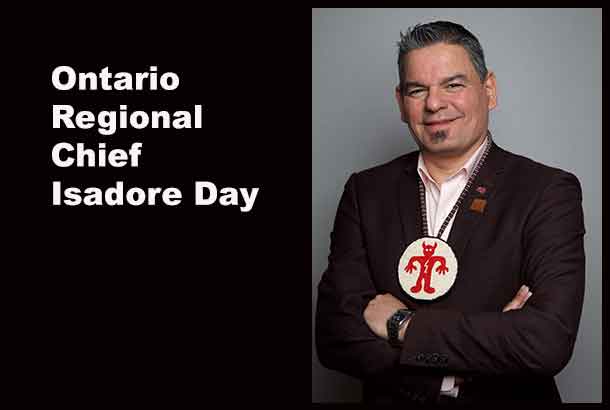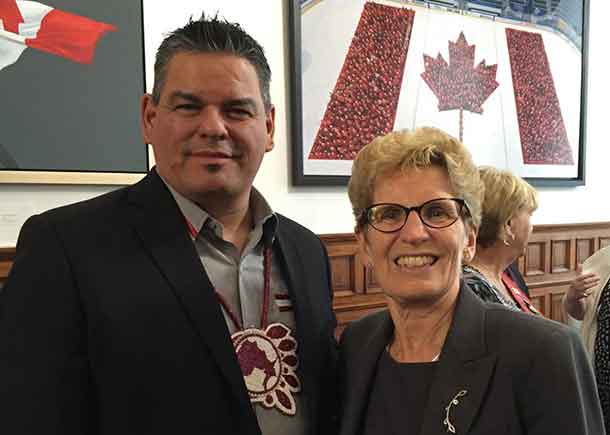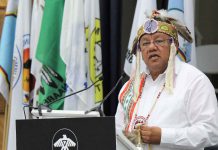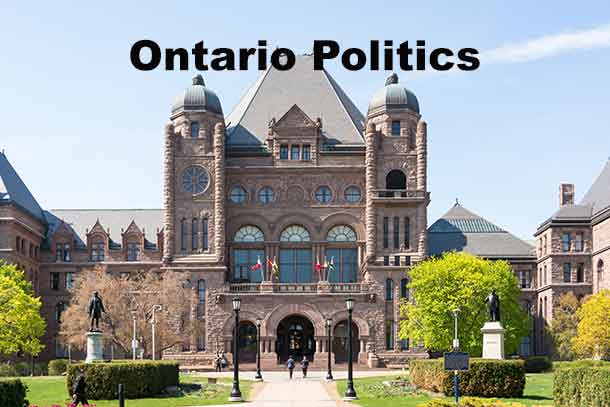 TORONTO, ON – Today, Ontario Finance Minister Charles Sousa unveiled the province’s budget announcing major funds directed at education, health and justice making community wellness a priority, however there was a clear absence of targeted investment in infrastructure, child welfare and climate change.
TORONTO, ON – Today, Ontario Finance Minister Charles Sousa unveiled the province’s budget announcing major funds directed at education, health and justice making community wellness a priority, however there was a clear absence of targeted investment in infrastructure, child welfare and climate change.
“First Nation leaders and community education professionals requested greater funding to further support Indigenous-led institutions and the Ontario government listened,” said Ontario Regional Chief Day. “The Province of Ontario is following through on its commitment to a renewed government-to-government relationship by signalling their investment in First Nation education. Funds must flow this coming year in order to elevate our communities to the same standards enjoyed by all Ontarians, where all families matter most.”

“Our leadership and youth underscored the need to move on critical areas – from child welfare to climate change – that will result in building better communities, and a stronger, healthier Ontario, for all,” added Regional Chief Day. “We acknowledged the current hardships faced in far too many of our communities, but we also spoke of the strengths that must be built upon in order to move forward towards a prosperous future for each of our communities.”
“For far too long, First Nations in Ontario have been victim to chronic quality-of-life issues, very noticeably in the Health, Justice and Poverty sectors,” said Ontario Regional Chief Isadore Day. “Today’s Ontario Budget focused on building a stronger, healthier Ontario and finally included long-awaited commitments, such as sustained funding to address health inequities and improve access to culturally appropriate health services over the long term, particularly in the North where the gaps are more evident.”
As highlighted in Ontario’s First Nations Health Action Plan (OFNHAP), Ontario is investing nearly $222 million over three years, followed by sustained funding of $104.5 million annually. While this is focused on northern First Nations where health circumstances of First Nations peoples are often critical, this commitment also includes investments in Indigenous health care across Ontario in home and community care, primary care, diabetes prevention and management both on and off-reserve.
“The immediate challenge in the coming months will be to dedicate a significant portion of this funding to address our Peoples’ emergency health crises and ensure predictable processes for these sustained investments. And, although not First Nations specific, there is also a welcomed $17 million investment in the province’s Improving Pain Management strategy, which will go a long way to address the chronic and underlying issues which lead to opioid dependence.”
Furthermore, First Nations’ often-neglected Justice sector received welcomed news: The Ontario government has provided 100 percent of the necessary funding to ensure that all First Nation police officers in communities across the province are remunerated at the same rate as those employed by the OPP. Furthermore, the government is also investing $44.2 million over three years to expand or establish programs that support a justice system which is culturally relevant and responsive to Indigenous communities, recognizing the unique needs and traditional processes of First Nations communities own justice systems.
The Ontario government’s commitment to policing matters underlines how critical emergency services are to the safety of our communities. However, it is sadly the reality that their federal counterparts continue to shirk and ignore their responsibility to protect our citizens. Without the federal government living up to its end of the cost sharing agreement and an absence of a legislative base to mandate these changes, it’s unclear as to whether First Nation police officers will only be compensated equitably for this fiscal year,” said Regional Chief Day.
Excerpts from the budget include:
- Ontario’s First Nations Health Action Plan (OFNHAP), Ontario is investing nearly $222 million over three years, followed by sustained funding of $104.5 million annually
- $44.2 million over two years to expand or establish programs that support a justice system which is culturally relevant and responsive to Indigenous communities
- 100% provincially-funded pay parity for First Nations police officers to OPP officers for the 2017 year
- On-Reserve electricity delivery credit; eliminating delivery charges for eligible households in addition to 25% average decrease in monthly bills
- Broadening Hydro One ownership as a collective benefit for First Nations, up to 2.5% of total current outstanding Hydro One shares at $18 per share
- $200 million over three years to support key initiatives that will help more First Nation, Métis and Inuit learners access high quality post secondary education and training opportunities
- $56 million over three years to enhance capacity and sustainability of nine publicly funded Aboriginal institutes in Ontario
- $4 million over two years to support development of 2 Indigenous designed and delivered anti-racism programs
“While there are positive elements in the 294 page budget, there is a clear absence of investment into First Nations infrastructure, including housing and transportation, child welfare and climate change,” said Regional Chief Day. “Without a clear investment into First Nations housing and equitable services for our fire fighters, I worry that the tragedies we have seen this year will continue in our communities.”
“By working together in the renewed spirit of the Political Accord and Reconciliation, we can build a better Ontario and generate not only a balanced budget, but a surplus budget as full partners.”






